Narrow Stance Squat
Author:
Unlock your full potential by engaging with our experts and community! Have questions about your fitness journey or looking for expert advice on weightlifting techniques? Don’t hesitate — leave a comment below and Oleksiy Torokhtiy will provide a personalized answer and insights to help you reach your goals.
Torokhtiy is reader-supported. Some links are affiliate links, and we may earn a commission at no extra cost to you. See our disclosure page for details.
What is Narrow Stance Squat?
The narrow stance squat is a variation of the traditional squat exercise where the feet are positioned closer together than in a regular squat, typically shoulder-width apart or narrower.
Olympic weightlifters often train the narrow squat stance because it helps them improve their technique and strength for the two Olympic lifts: the snatch and the clean and jerk.
Firstly, by training the narrow stance squat, weightlifters can improve their ability to stabilize their body in this position and develop the necessary strength in their lower body to generate power from this stance.
Secondly, the close stance squats emphasizes the quadriceps, which are a key muscle group used during the initial phase of the snatch and clean and jerk, where the lifter must generate force to lift the barbell off the ground. By strengthening the quadriceps through the narrow stance squat, weightlifters can improve their explosive power and generate more force to lift heavier weights.
Finally, the narrow stance squat can also improve an athlete’s balance and stability, which are crucial for Olympic weightlifting movements that require precision and coordination.
By training the narrow stance squat, weightlifters can improve their overall lower body stability and develop better balance and control during the snatch and clean and jerk.
Overall, the narrow stance squat is a valuable exercise for Olympic weightlifters, as it can help them improve their technique, strength, and balance for the two main Olympic lifts.
Muscles Worked With Close Stance Squats
The close stance squat primarily targets the lower body muscles, specifically the quadriceps, hamstrings, and glutes. Here’s a breakdown of what does narrow stance squat work :
Quadriceps: The quadriceps, located on the front of the thigh, are the primary muscle group targeted during close stance squats. The quadriceps are responsible for extending the knee joint and straightening the leg.
Hamstrings: The hamstrings, located on the back of the thigh, are also worked during close stance squats. They act as the antagonist to the quadriceps and are responsible for flexing the knee joint.
Glutes: The glutes, or the muscles of the buttocks, are also activated during close stance squats. They assist with hip extension and contribute to the overall stability of the lower body during the exercise.
Adductors: The adductors, located on the inner thigh, are also recruited during close stance squats. They help to stabilize the hips and maintain proper form during the exercise.
Calves: The calves, located on the back of the lower leg, are also worked during close stance squats, particularly during the upward phase of the movement when the individual is pushing through the balls of their feet to stand up.
Overall, close stance squats are an effective exercise for developing lower body strength and muscle mass, particularly in the quadriceps and glutes. They can also improve overall lower body stability and balance, making them a great addition to any leg day routine.
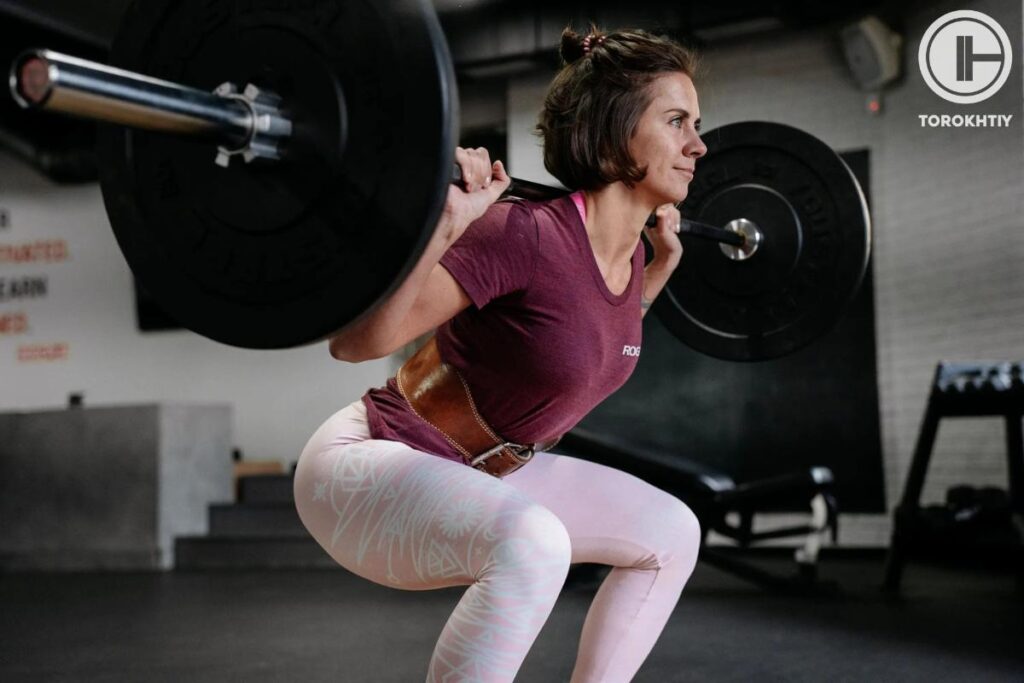
How to Perform Narrow Stance Squats?
Begin by setting up the barbell on a squat rack at a height that is comfortable for you to lift off. Adjust the weight on the bar to your desired level.
Approach the bar and position yourself underneath it with your feet shoulder-width apart or slightly narrower. Position the bar on your upper back, resting it on your traps, just below the base of your neck.
Engage your core muscles and maintain a straight back throughout the movement. Keep your chest up and shoulders back, with your head in a neutral position.
Take a deep breath in and brace your core, then lift the bar off the rack and step back, taking a few small steps backward until you have enough space to perform the squat.
Position your feet so that they are directly underneath your hips or slightly closer together. Keep your feet slightly turned out, with your toes pointing slightly outward.
Take another deep breath in and brace your core, then slowly lower your body by bending your knees and hips simultaneously. Keep your weight on your heels and maintain a straight back throughout the movement. Lower your body until your thighs are slightly lower than parallel to the ground. Right after push through your heels and extend your knees and hips to return to the starting position.
Repeat the movement for the desired number of repetitions.
Some additional tips to keep in mind when performing close feet stance barbell back squats:
Ensure that the bar is positioned on your upper back and not on your neck or lower back, as this can cause discomfort or injury.
Keep your elbows tucked in and pointing downward throughout the movement to maintain stability in your upper body.
Avoid leaning forward or allowing your knees to collapse inward during the movement, as this can place unnecessary strain on your lower back and knees.
Start with a lighter weight and gradually increase the weight as you become more comfortable with the movement and your form improves.
Pros & Cons
The barbell back squat is one of the most effective exercises for building lower body strength and muscle mass. However, there is an ongoing debate about whether a close feet stance or a wider stance is better. In this response, we will explore the pros and cons of the close feet stance barbell back squat.
1. Pros
Quicker Activation of Quadriceps
A close feet stance barbell back squat places more emphasis on the quadriceps muscles. This is because the closer stance requires more knee flexion and extension, which leads to more quad activation. This can be beneficial for those who want to target their quads more specifically.
Increased Core Activation
A close feet stance requires more core engagement to maintain balance and stability. This can lead to greater overall strength gains in the core muscles.
Improved Ankle Mobility
A close feet stance requires greater ankle mobility than a wider stance. This can be beneficial for those who have limited ankle mobility or who want to improve their ankle flexibility.
2. Cons
Increased Stress on the Knees
A close feet stance places more stress on the knees than a wider stance. This can increase the risk of knee injury, especially if proper form is not maintained.
Limited Hip Activation
A close feet stance limits the amount of hip activation during the squat. This can be detrimental for those who want to target their glutes and hamstrings more specifically.
Reduced Stability
A close feet stance can be less stable than a wider stance, especially for those who have poor balance or a weak core. This can increase the risk of injury if proper form is not maintained.
Overall, the close feet stance barbell back squat can be a highly effective exercise for building lower body strength and muscle mass, especially for those who want to target their quadriceps more specifically. However, it may not be the best option for everyone, especially those with knee issues or who want to target their glutes and hamstrings more specifically.
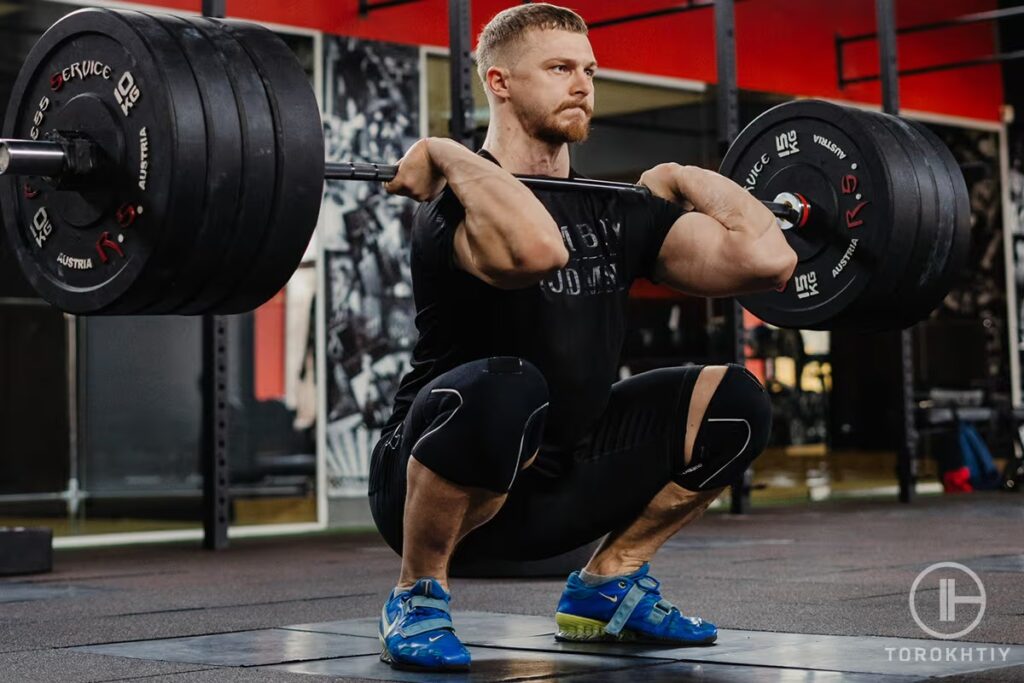
Key Factors in Narrow Stance Squat
Here are some key factors to keep in mind when performing the narrow stance squat:
1. Foot Placement
The feet should be positioned directly under the hips or slightly narrower. This will depend on individual mobility and comfort. The toes can be pointed slightly outward to allow for greater range of motion.
2. Hip and Knee Alignment
It is important to maintain proper alignment between the hips and knees during the squat. The knees should track over the toes and not cave inward, while the hips should remain level and not shift to one side.
3. Core Engagement
The narrow stance squat requires greater core engagement to maintain balance and stability. The abdominals and lower back muscles should be braced throughout the movement.
4. Depth of Squat
The depth of the squat will depend on individual mobility and comfort. However, the hips should be lowered to at least parallel with the knees to ensure adequate muscle activation and range of motion.
5. Bar Placement
The bar should be positioned across the upper back, with the hands gripping the bar slightly wider than shoulder-width apart. The bar should be held securely and not allowed to roll down the back during the squat.
6. Breathing Technique
Proper breathing technique can help with core engagement and stability during the squat. Take a deep breath before descending into the squat and exhale forcefully upon rising from the bottom position.
7. Gradual Progression
It is important to gradually increase weight and intensity over time to avoid injury and ensure proper form. Start with a lighter weight and focus on perfecting technique before increasing load.
Main Mistakes in Narrow Stance Squat
Here are some common mistakes to avoid when performing the narrow stance squat:
1. Positioning of the Foot
Placing the feet too close together or too far apart can negatively affect balance and stability during the squat. The feet should be positioned directly under the hips or slightly narrower to ensure proper alignment and range of motion.
2. Knee Positioning
Allowing the knees to collapse inward or flare out during the squat can put unnecessary stress on the knee joints and increase the risk of injury. The knees should be kept in line with the toes throughout the movement.
3. Core Engagement
Failing to engage the core muscles can lead to instability and poor form during the squat. The abdominals and lower back muscles should be braced throughout the movement to maintain proper alignment and stability.
4. Squat Depth
Failing to achieve adequate depth during the squat can limit muscle activation and range of motion. The hips should be lowered to at least parallel with the knees to ensure proper form and activation.
5. Placement of the Barbell
Placing the bar too high or too low on the back can lead to improper form and discomfort during the squat. The bar should be positioned across the upper back, with the hands gripping the bar slightly wider than shoulder-width apart.
6. Inhaling & Exhaling
Improper breathing technique can affect core engagement and stability during the squat. It is important to take a deep breath before descending into the squat and exhale forcefully upon rising from the bottom position.
7. Rushing the Movement
Performing the squat too quickly or without proper control can increase the risk of injury and limit results. The movement should be performed slowly and with proper form to ensure maximum muscle activation and injury prevention.
Narrow Stance Squat Variations
The narrow stance squat is a variation of the barbell back squat that involves placing the feet closer together than in a traditional squat. This variation can be modified in several ways to add variety to your workout and target different muscle groups. Here are some variations of the narrow stance squat:
1. Front Squat
The front squat involves placing the barbell across the front of the shoulders instead of the upper back. This variation can be challenging for the core and requires greater quadriceps activation.
2. Zercher Squat
The Zercher squat involves holding the barbell in the crook of the elbows instead of on the shoulders. This variation can be more comfortable for some people and can target the quadriceps and glutes.
3. Narrow Stance Goblet Squat
The goblet squat involves holding a kettlebell or dumbbell at chest level during the squat. This variation can help with form and can target the quadriceps and glutes.
4. Narrow Stance Smith Machine Squat
A smith machine close stance squats is a variation of the squat exercise performed on a Smith machine, which is a piece of weight training equipment that consists of a barbell fixed within steel rails. The Smith machine provides a guided path of motion, which can help the lifter maintain proper form and stability during the exercise.
5. Narrow Stance Hack Squat
The narrow stance hack squat is a variation of the squat exercise that targets the quadriceps, glutes, and hamstrings. It is performed using a hack squat machine or a barbell, and the stance is narrower than a traditional squat.
6. Pause Squat
The pause squat involves pausing at the bottom of the squat for a few seconds before rising. This variation can help with building strength and can target the quadriceps and glutes.
7. Tempo Squat
The tempo squat involves slowing down the descent and ascent of the squat to increase time under tension. This variation can help with building muscle and can target the quadriceps and glutes.
8. Bulgarian Split Squat
The Bulgarian split squat involves standing with one foot in front of the other on an elevated surface such as a bench. This variation can target the quadriceps and glutes while also improving balance and stability.
Narrow Stance Squat Alternatives
If you are unable to perform the narrow stance squat due to injury, mobility issues, or discomfort, there are several alternative exercises you can try to target similar muscle groups. Here are some alternatives to the narrow stance squat:
1. Leg Press
The leg press is a machine exercise that targets the quadriceps, glutes, and hamstrings. This exercise can be a good alternative to the narrow stance squat for those with mobility or balance issues.
2. Step-ups
Step-ups involve stepping onto a raised platform with one foot and then bringing the other foot up to meet it. This exercise targets the quadriceps, glutes, and hamstrings while also improving balance and stability.
3. Lunges
Lunges involve stepping forward or backward with one foot and bending the knees to lower the body into a lunge position. This exercise targets the quadriceps, glutes, and hamstrings while also improving balance and stability.
4. Box Squats
Box squats involve squatting down to a box or bench and then standing back up. This exercise can be performed with a wider stance and can target the quadriceps, glutes, and hamstrings while also improving form and technique.
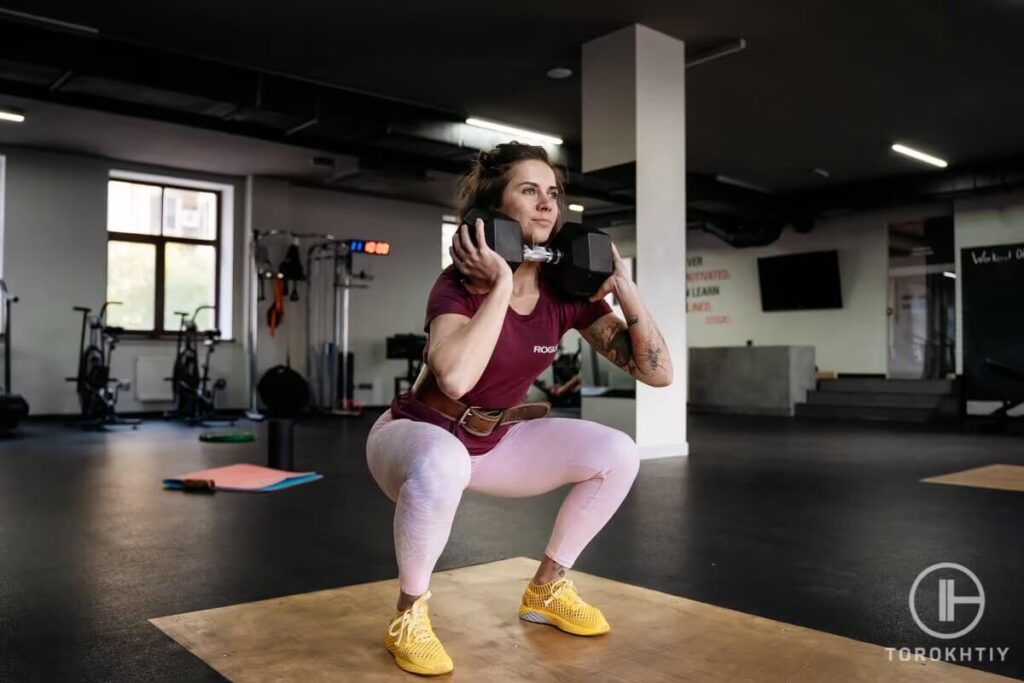
Who Should Use Narrow Stance Squats?
Here are some individuals who may benefit from incorporating the narrow stance squat into their workout routine:
1. Powerlifters
The narrow stance squat is a popular exercise among powerlifters as it can help improve squat form and technique, increase quadriceps and glute activation, and build strength in the lower body. Also, narrow stance squats can be used as an accessory exercise to target specific areas of weakness in the squat movement.
For example, if a powerlifter struggles with locking out at the top of the squat, adding narrow stance squats as an accessory exercise can help improve their strength and technique in that area.
By incorporating narrow stance squats into their training program, powerlifters can improve their mobility and flexibility in the hips and ankles. This can translate to improved technique and performance in other exercises, such as the deadlift and squat.
2. Athletes
The narrow stance squat can be beneficial for athletes who require explosive power and strength in the lower body, such as sprinters, jumpers, and football players.
3. Bodybuilders
The narrow stance squat can help bodybuilders target the quadriceps, glutes, and hamstrings while also promoting muscle growth in the lower body. Also, narrow stance squats can help bodybuilders improve the definition and separation of their leg muscles, particularly the quadriceps. This can enhance the overall aesthetic appearance of their physique. Incorporating different squat variations, such as the narrow stance squat, can help bodybuilders avoid plateauing and keep their training program interesting and challenging.
4. Individuals with Limited Mobility
The narrow stance squat can be easier to perform for those with limited mobility or flexibility in the hips, ankles, or knees.
5. Those Looking to Improve Balance and Stability
The narrow stance squat requires greater balance and stability than a wider stance squat, making it a good exercise for those looking to improve their overall balance and stability.
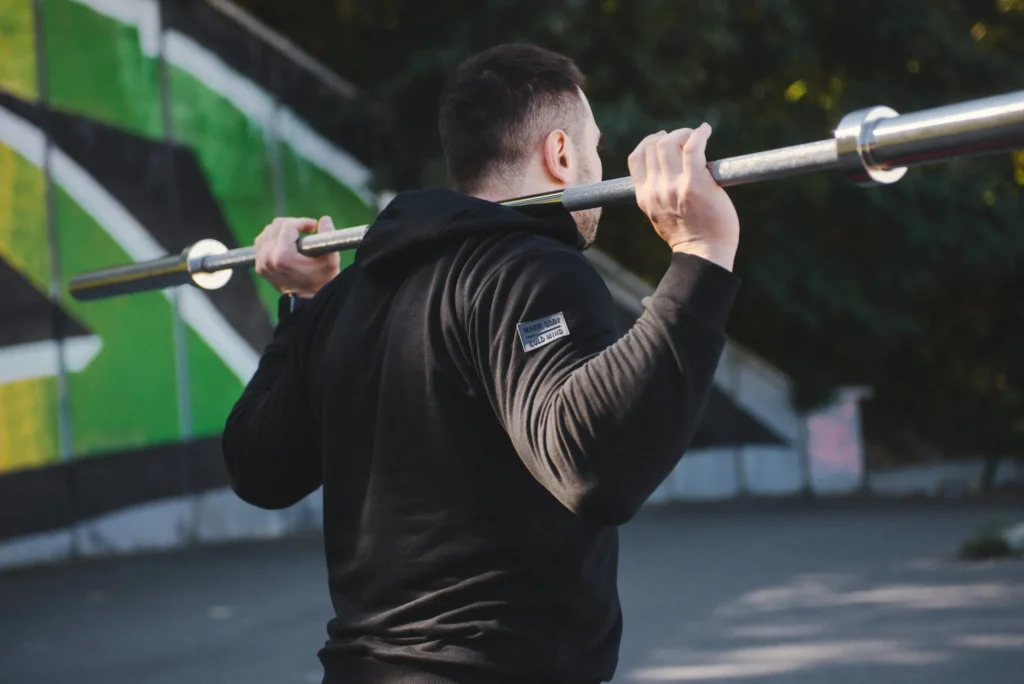
How To Incorporate Narrow Stance Squat Into The Olympic Weightlifting Training Program?
The narrow stance squat can be a beneficial exercise to incorporate into an Olympic weightlifting training program as it can improve squat form and technique, increase quadriceps and glute activation, and build strength in the lower body. Here are some tips for incorporating the narrow stance squat into your Olympic weightlifting training program:
1. Warm-up
Before starting any squat exercise, it is important to properly warm up the body. Begin with some dynamic stretching and foam rolling to increase blood flow and mobility in the lower body.
2. Incorporate it into Squat Variations
The narrow stance squat can be incorporated as a variation of the back squat or front squat in your training program. Start with lighter weight and gradually increase weight over time as you perfect your form and technique.
3. Use it as an Assistance Exercise
The narrow stance squat can be used as an assistance exercise to target specific areas of weakness in the squat movement. For example, if you struggle with locking out at the top of the squat, adding narrow stance squats as an accessory exercise can help improve your strength and technique in that area.
4. Vary the Reps and Sets
To get the most benefit from the narrow stance squat, vary the reps and sets in your training program. For example, you can perform heavy sets of 3-5 reps to build strength, or lighter sets of 8-12 reps to promote muscle growth and endurance.
5. Incorporate it into Complexes
Complexes involve performing several exercises back-to-back without rest. You can incorporate narrow stance squats into complexes with other exercises such as deadlifts or lunges to create a full-body workout.
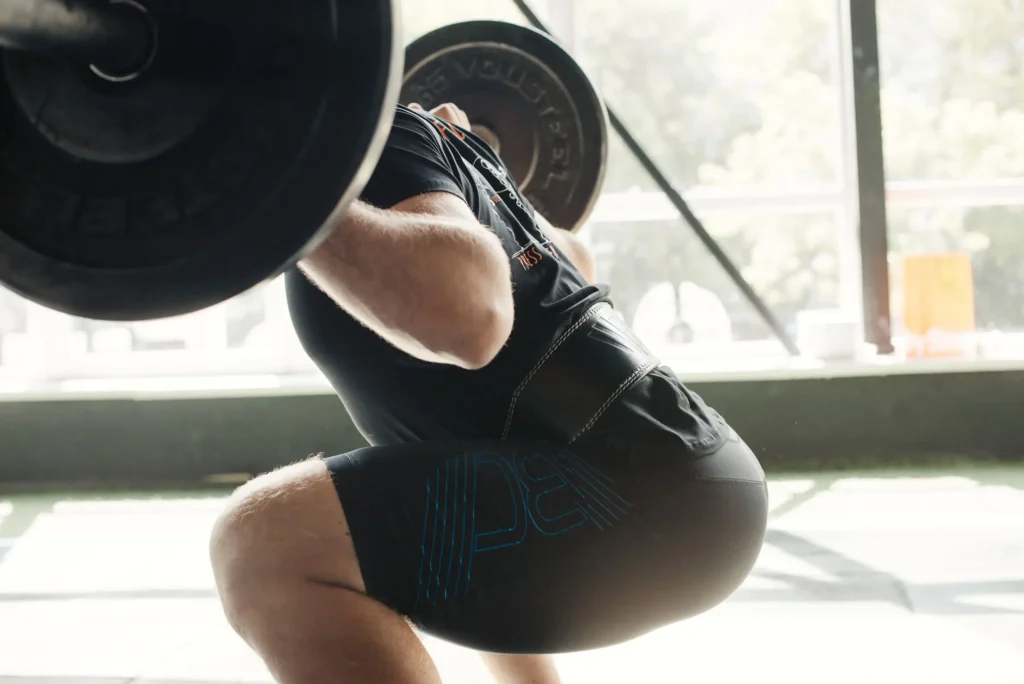
Overall, incorporating the narrow stance squat into your Olympic weightlifting training program can be a beneficial way to improve your overall strength, technique, and performance in the squat movement. It is important to start with proper form and gradually increase weight and intensity over time while listening to your body and avoiding any pain or discomfort.
Also read:
Why Trust Us?
With over 20 years in Olympic weightlifting, strength training, nutrition coaching, and general fitness our team does its best to provide the audience with ultimate support and meet the needs and requirements of advanced athletes and professional lifters, as well as people who strive to open new opportunities and develop their physical capabilities with us.
By trusting the recommendations of our certified experts in coaching, nutrition, and sports training programming, as well as scientific consultants, and physiotherapists, we provide you with thorough, well-considered, and scientifically proven content. All the information given in the articles concerning workout programming, separate exercises, and athletic performance, in general, is based on verified data.
The product testing process is described in more detail here.
Author: Oleksiy Torokhtiy
Olympic Weightlifting Champion, PhD in Sport Science
Best Results: Snatch – 200 kg,
C&J – 240 kg
Oleksiy Torokhtiy is a professional athlete boasting 20 years of experience in Olympic weightlifting. With multiple European and World titles under his belt, he has showcased his prowess in two Olympic Games (Beijing 2008 and London 2012). Upon concluding his illustrious career, Oleksiy dedicated himself to coaching. By 2022, he had conducted over 200 weightlifting seminars worldwide. He is the visionary behind an international sportswear and accessories brand known for its motto, “Warm Body Cold Mind.” Additionally, he is an esteemed author and the creator of a series of training programs and eBooks.



Still have questions after reading our article? Unlock your full potential by engaging with our experts and community! Don’t hesitate — leave a comment below and Oleksiy Torokhtiy will provide a personalized answer and insights to help you reach your goals.